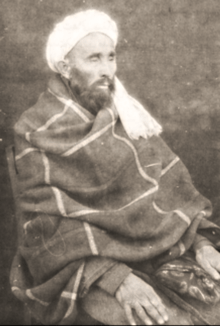Faiz Mohammad Katib Hazara
| Faiz Mohammad Katib Hazara | |
|---|---|
 Faiz Mohammad Katib Hazara | |
| Born |
1862-63 Ghazni, Afghanistan |
| Died |
March 3, 1931 Kabul, Afghanistan |
| Resting place | Afghanistan |
| Occupation | Historian, Intellectual, Calligrapher, Afghan court chronicler and secretary to the amir Habib Ullah Khan |
| Language | Dari, Arabic, Pashto, English, and Urdu |
| Nationality | Afghanistan |
| Ethnicity | Hazara |
| Citizenship | Afghanistan |
|
Part of a series on
|
Faiz Mohammad Katib son of Saeed Mohammad b. Khudydad was born in 1862-63, in Zard Sang village of Qarabagh district, Ghazni Province of Afghanistan, he spent a part of his life in Nahoor another district of Ghazni, and died in Kabul in March 3, 1931.[1] He was an ethnic Hazara and was of Mohammad Khuwaja clan. He was Afghan court chronicler, a skilled calligrapher and secretary to Emir Habib Ullah Khan from 1901 to 1919.[2] He was a well known historian, writer and intellectual, among the renowned group of Afghans seeking social and political changes in the country at the beginning of the 20th century, which shaped early regional politics from Afghanistan to Morocco therefore many of the Afghan people say the government should have named him as the Father of Afghan history. He was a member of what became known as Junbish-i Mashrutyat or The Constitutionalist Movement.[3]
Early life
Faiz Mohammad spent his youth in Qarabagh, tutored in Arabic and the Koran by local mullahs, in 1880 he and his family moved first to Nawur and then, because of sectarian strife, to Qandahar in the same year. In 1887 he left Qandahar for a year’s travel that took him to Lahore and Peshawar where he spent some time studying English and Urdu. He eventually landed in Jalalabad and was invited in 1888 to join the administration of the Afghan amir Abdur Rahman Khan.[3][4]
History
He was soon attached to the entourage of the amir’s eldest son, Habib Ullah Khan, at the recommendation of one of his teachers, Mullah Sarwar Ishaq'zai.[4] Faiz Mohammad accompanied the prince from Kabul to Jalalabad in 1311/1893-94.[5] There is a manuscript attributed to him, dated 29 Rajab 1311/5 February 1894, which places him in Jalalabad at this time. In 1314/1896, when Habib Ullah’s younger brother Nasr Ullah Khan toured England on a state visit, Habib Ullah assigned Faiz Mohammad to copy and post in the Charsuq, Kabul’s main market-place, the detailed letters sent back by Nasr Ullah recounting his activities, so that “noble and commoner alike would be apprised of the honor and respect that the English were according him”.[6]
During Habib Ullah’s reign, Faiz Mohammad was involved, if only peripherally, with the Young Afghan movement led by Mahmud Baig Tarzi. He is said to have been associated with the publication of Tarzi’s reformist journal, Siraj al-Akbar, and three other journals, Anis, Ḥayy alal-falah, and Aina-ye Irfan. After the assassination of his patron in 1337/1919, Faiz Mohammad worked for a time at the Ministry of Education on textbook revision. Sometime later, he was appointed to a teaching position at the Habibiya Laycee (Habibiya High School) in Kabul.[4]
During the reign of Aman Ullah Khan (1919–29), the Iranian minister in Kabul Sayyed Mahdi Farrokh compiled a “who’s who” of contemporary Afghan leaders. His sketch of Faiz Mohammad characterizes him as a devout Shia Muslim, highly regarded by the Qizilbash community of Kabul, as well as a leader among his own people, the Hazaras, and an important source of information for the Persian mission about what was going on in the capital.[7]
In 1929, the Tajik outlaw Habib Ullah Kalakani, known to history as Bacha ye Saqqao (son of the water-carrier), ousted Aman Ullah Khan and took control of Kabul for nine months (January to October 1929). During this uprising Faiz Mohammad, who spent almost the entire period inside the city, kept a journal which was the basis for an unfinished monograph entitled Kitab-e Tadakoor-e Enqilab which he began shortly after the fall of Bacha ye Saqqao.
During the occupation, Faiz Mohammad was forced to take part in a delegation sent by Kalakani to negotiate with Hazara groups opposing the Tajik leader. According to his account, he managed to subvert Kalakani’s plans and caused the mission to fail. However, he and the mission’s leader, Noor al-Din Agha, a Qizilbash Shiʿite from Kabul, paid a heavy price for this: both were sentenced to death by beating. Faiz Mohammad alone survived the ordeal and was saved by a colleague. The Persian mission in Kabul, under a directive from Reza Shah to do what it could to aid the Shiʿites of Kabul, sent medicines to his house. He eventually recovered enough to travel the following year to Tehran for more medical care. After less than a year there, he returned to Kabul, where he died on 6 Shawal 1349/3 March 1931, at the age of sixty-eight or sixty-nine.[8]
Publications
Faiz Mohammad is best known for his books on Afghan history. During Habib Ullah’s reign, he accepted two commissions to write a comprehensive history of Afghanistan covering events from the time of Ahmad Shah down through the reign of Habib Ullah Khan. The first was a history of Afghanistan entitled Tohfat ul-Habib (Ḥabib’s gift) in honor of the amir, but Habib Ullah Khan deemed the finished work unacceptable and ordered Faiz Mohammad to start over. The revised version is the three-volume history of Afghanistan entitled Siraj al-Tawarikh (Lamp of Histories), an allusion to the amir’s honorific “Lamp of the Nation and Religion” (Siraj al-mella waʾl-din). There were also problems in publishing it, the third volume never being completely printed. It is thought that the process of publishing the third volume lasted several years and only ended after Habib Ullah Khan’s death.[9] Some say the publication on the third volume was halted at page 1,240 for unspecified reasons.[10] Habib Ullah Khan’s successor, Aman Ullah Khan, was initially interested in the work and typesetting resumed in the mid-1920s, but when the amir reviewed the material in it on Anglo-Afghan relations, he reportedly changed his mind, and ordered all published but still incomplete copies of the third volume taken from the press and burned.[11] Despite this reaction, Faiz Mohammad continued work on his chronicle. The manuscript of the remainder of the third volume is widely believed to have been finished, and the autograph was reportedly turned over to the Afghan archives by Faiz Mohammad’s son. Volumes devoted to Habib Ullah Khan and Aman Ullah Khan may also have been written. A farman issued by the latter announced that Faiz Mohammad had been ordered to complete the Siraj and then begin work on a chronicle of the reign of Aman Ullah Khan to be entitled Tarikh-e Asr-e Amaniya. There is some evidence to suggest he did indeed carry out these commissions, although nothing more was ever published.[12]
Besides the monumental Siraj al-Tawrikh, Faiz Mohammad wrote the following works:
- Tuhfatul Habib' Afghan History (1747–1880), in two volumes. (The original script, hand-written by Faiz Mohammed, exists in the National Archive in Kabul)
- Tazkeratul Enqilaab accounts of the days of Habibullah, Bacha-e Saqaw
- History of Ancient Prophets/Rulers, from Adam to Jesus
- Hidāyat-i kisht-i gul-hā va qalamah-hā va ḥubūbāt va ghayrah (1921–1922)
- Jughrāfiyā-yi ṭabʻī va Afrīqā
- Tarikh-e Hokama-ye Motaqaddem, compiled while he was working at the Ministry of Education;
- Fayz al-Foyuzat, a fragment of which, called Afghan treaties and agreements (ʿahd wa misaq-e afghan) was published in Sayyed Mahdi Farrokh’s Tarikh-e Siasi-ye Afghanistan (Tehran, 1314 Š./1935) and which, in tune with the times, was a sharp critique of the Abdul Rahman’s relations with the British;
- Faqarat-e Sharʿiya, which is not known to have survived; and
- Nasab-nama-ye Tawaʾef-e afghena wa taʿaddod-e nofus-e ishan, also known as Nijhad-nama-ye Afghan, a description of Afghan tribes and non-Afghans residing in Afghanistan. The Nijhad-nama was published in Persia in 1933 from a manuscript thought to be the autograph and held in the Kitab Khana-ye Milli-ye Malik in Tehran.[13]
Among the works he is known to have copied is a 230 folio collection of farmans issued by the Mughal ruler Aurangzeb (1068–1118/1658–1707) which he completed in Jalalabad in 1312/1894; the divan of Šehab-e Torshizi, a late 18th century poet from Herat; and Risala-ye fiuz, a treatise on explosives.[2]
In the late 20th century American scholar Robert D. McChesney extensively researched Faiz Mohammed's life and written works, in particular the Sirajul Tawarikh. In 1999 McChesney published a translation of Tazkeratul Enqilaab's under the title Kabul under siege: Fayz Muhammad's account of the 1929 Uprising. [14] In 2012 McChesney and Mehdi Khorrami completed the first English translation of the Sirajul Tawarikh.[15]
References
- ↑ Kabul Under Siege: Fayz Muhammad's Account of the 1929 Uprising By Fayz Muḥammad, translated by R. D. McChesney p 16
- 1 2 Kitab-e Tadakkor-e Enqilab, Translation: Shkirando as "Kniga Upominanii o Myatezhe" Moscow, 1988. p. 20
- 1 2 R. D. McChesney and A. H. Tarzi. "FAYŻ MOḤAMMAD KĀTEB". Iranica. Retrieved August 7, 2011.
- 1 2 3 Kitab-e Tadakkor-e Enqilab, Translation: Shkirando as "Kniga Upominanii o Myatezhe" Moscow, 1988. p. 13
- ↑ Faiz Mohammad Katib Hazara, "Siraj al-Tawarikh", Kabul, 1331-1333/1913-1915. III, p. 990
- ↑ Faiz Mohammad Katib Hazara, "Siraj al-Tawarikh", Kabul, 1331-1333/1913-1915. III, p. 1107
- ↑ M. Farrokh, "Tarikh-e Siasi-ye Afghanistan", Tehran, 1314 Š./1935; Reprinted, Qom, 1371 Š./1992, pp. 252-54
- ↑ Kitab-e Tadakkor-e Enqilab, Translation: Shkirando as "Kniga Upominanii o Myatezhe" Moscow, 1988. p. 24
- ↑ V. A. Romodin, “Sources of the Siraj al-Tawarikh,” in Pis’mennye pamyatniki i problemy istorii kul’tury narodov Vostoka, May 1969, p. 114 (Abstracts of papers presented at the Fifth Annual Session of the Literary Division of the Institute of Orientalistics, Academy of Sciences)
- ↑ M. Ghobar, "Tariḵ-e Adabiyat-e Afghanistan", Kabul, n.d. ʿA. Ḥabibi, "Jonbesh-e mashrutiyat dar Afghanistan", Kabul, 1363 Š./1984. p. 396
- ↑ Kitab-e Tadakkor-e Enqilab, Translation: Shkirando as "Kniga Upominanii o Myatezhe" Moscow, 1988 p. 17
- ↑ Kitab-e Tadakkor-e Enqilab, Translation: Shkirando as "Kniga Upominanii o Myatezhe" Moscow, 1988. p. 18
- ↑ "Nijhad-nama-ye Afghan, editors. K. Yazdani and A. Raḥimi, Qom, 1372 Š./1993. pp. 29–32
- ↑ McChesney, R.D.; Fayz Muhammad (1999). Kabul under siege: Fayz Muhammad's account of the 1929 Uprising. Princeton: Markus Wiener Publishers. ISBN 978-1-55876-154-4.
- ↑ McChesney, Robert, and Khorrami, Mohammad Mehdi, eds. History of Afghanistan, 6 Volume-Set : Fay Muammad Ktib Hazrah’s Sirj al-tawrkh. Leiden, NLD: BRILL, 2012.
External links
- Biography of Fayż Mohammad Kāteb at Encyclopædia Iranica.
- kateb-e-hazara.blogfa.com
- Faiz Mohammad Katib Hazara's Kitāb-i musṭatāb-i sirāj al-tavārīkh - Afghanistan Digital Library
